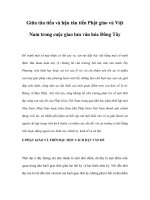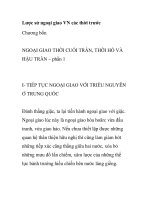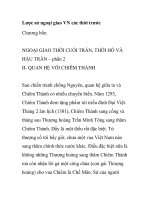COVID va hậu COVID
Bạn đang xem bản rút gọn của tài liệu. Xem và tải ngay bản đầy đủ của tài liệu tại đây (2.49 MB, 23 trang )
SARS‐CoV‐2 and Post‐Acute
Sequelae of COVID‐19
Asso. Prf. Nguyen Van Tri
HoChiMinh City
TẠI SAO NGƯỜI CAO TUỔI THUỘC NHÓM
NGUY CƠ CAO SAU NHIỄM SARC‐CoV‐2 ?
Tăng yếu tố đơng máu và Tăng yếu tố viêm
là q trình tự nhiên của tích tuổi khơng liên quan đến đa bệnh
Am J Med. 2009 Jul;122(7):605‐13.doi: 10.1016/j.amjmed.2009.01.030.
Resources
▪ CDC webpages on post‐COVID:
– For the general public: />ncov/long‐term‐effects.html
– Forclinicians: />ncov/hcp/clinical‐care/post‐covid‐conditions.html
▪ NIH Workshop on Post‐Acute Sequelae of COVID‐19 –
Day1: />Day2: />CDC,Centers for Disease Control and Prevention
NIH,National Institutes of Health
Knowledge of post‐COVID conditions is likely to
change rapidly with ongoing research
• With extensive research underway, it is likely that evidence‐based
treatment practices will evolve over time
Nội dung
• Định nghĩa
• Cơ chế
• Chẩn đốn
• Xử trí
Post COVID‐19 as defined:
Long COVID
‘’Signs and symptoms that develop during or following
an infection consistent with COVID 19 which continue
for more than 12 weeks and are not explained by an
alternative diagnosis’’
‘’it usually presents with clusters of symptoms, often
overlapping, which can fluctuate and change over
time and can affect any system of the body’’
NICE/SIGN/RCGP
Nội dung
• Định nghĩa
• Cơ chế
• Chẩn đốn
• Xử trí
Post-traumatic stress disorder (PTSD)
The predominant pathophysiologic mechanisms of acute
COVID‐19 include the following:
• Direct viral toxicity
• Endothelial damage
• Microvascular injury
PathophysiologyofpostacuteCOVID19
ã Potentialmechanismscontributingtothepathophysiologyofpost
acuteCOVID19include:
ã
ã
ã
ã
cytopathicdamage
immunedysregulation
inflammatory tissuedamage
Microvascularischemia(clot)andinjury
ã ẵcasesarethepostintensive caresyndrome
LANCET
• Increased arterial and venous thrombosis in severe and non severe
disease
• Microthrombi seen in lungs, heart, liver and kidney
Nội dung
• Định nghĩa
• Cơ chế
• Chẩn đốn
• Xử trí
Listen to and validate patients’ experiences and partner
with patients to identify achievable health goals
• Most post‐COVID conditions can be diagnosed and managed by
primary care
• Consider referral to multidisciplinary post‐COVID care centers
• Many post‐COVID conditions may be diagnosed based on history and
physical exam
– Potential harms could arise from excessive testing
• Consider conservative diagnostic approach in the first 4 to 12 weeks
• Symptoms persisting beyond three months should prompt further
evaluation
Commonly reported symptoms include dyspnea, fatigue,
post‐exertional malaise, and brain fog
For clinical features warranting further evaluation,
consider broad range of possible post‐COVID conditions
A thorough physical examination should be completed
• Evaluate ambulatory pulse‐
oximetry with respiratory
symptoms, fatigue, malaise
• Orthostatic vital signs with
postural symptoms, dizziness,
fatigue, cognitive impairment,
malaise
At this time, no laboratory test can definitively distinguish
post‐COVID conditions from other etiologies
• Lab testing should be guided by clinical findings
• A basic panel of lab tests might be considered between 4 and 12
weeks
• Consider additional testing if symptoms persist for 12 weeks or longer
More evidence is needed to support the utility of specific
imaging tests for evaluation of post‐COVID conditions
• Some imaging tests may have low yield
– CT chest with normal chest x‐rays and normal oxygen saturation
– CT pulmonary angiogram without an elevated D‐dimer and
compatible symptoms
– Brain MRI with brain fog
• More specialized imaging studies (e.g., cardiac MRI) might merit
consultation with specialists
Nội dung
• Định nghĩa
• Cơ chế
• Chẩn đốn
• Xử trí
For most patients, the goal of medical management is to
optimize function and quality of life
• Creating a comprehensive rehabilitation plan may be helpful for some
patients
• Many post‐COVID conditions can be improved through already
established symptom management approaches
Individual approach









